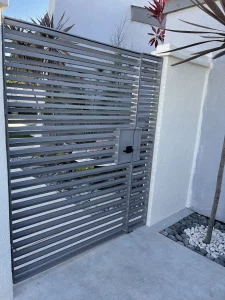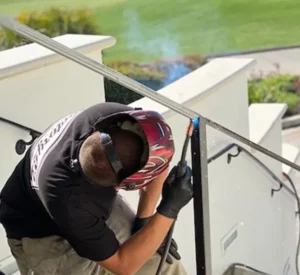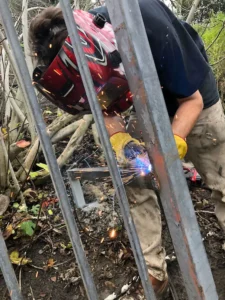Metal fabrication is a crucial industry that plays a significant role in the economy of Santa Ana, CA. From manufacturing to construction, metal fabrication is integral to various industries. We will explore the basics of metal fabrication, its importance in Santa Ana, the process involved, and future trends in the field.
Understanding Metal Fabrication
Metal fabrication is the process of transforming raw metal materials into finished products through various techniques. It involves cutting, bending, welding, and assembling metal components to create structures and machinery that serve different purposes.
When it comes to metal fabrication, there are many fascinating details to explore. Let’s delve deeper into the world of metal fabrication and uncover some interesting facts.
The Basics of Metal Fabrication
At its core, metal fabrication consists of three primary stages: cutting, shaping, and assembling. Cutting involves using different tools such as lasers, shears, or saws to slice metal sheets into the desired shape and size.
Did you know that lasers are often used in metal fabrication due to their precision and efficiency? Laser-cutting machines can produce intricate designs and patterns with minimal material wastage.
Shaping is the process of bending or forming metal to create specific components or structures. This can be achieved through techniques like machining, punching, or bending.
One interesting technique used in metal shaping is machining. Machining involves using specialized tools like lathes, drills, and milling machines to remove excess material and shape the metal. This precise method allows fabricators to create intricate and complex designs with ease.
Lastly, assembling involves joining different metal components together using various methods such as welding, riveting, or bolting.
Welding, a widely used process in metal fabrication, involves joining two or more metal pieces together using heat and pressure. This technique creates strong and durable bonds between the components.
Different Types of Metal Fabrication Processes
Metal fabrication encompasses a wide range of processes, each tailored to meet specific needs and requirements. Let’s explore some common types of metal fabrication processes:
- Machining: This involves using specialized tools like lathes, drills, and milling machines to remove excess material and shape the metal. Machining is commonly used in industries such as aerospace and automotive, where precision is crucial.
- Welding: A widely used process that involves joining two or more metal pieces together using heat and pressure. Welding can be performed using various techniques such as arc welding, MIG welding, or TIG welding, depending on the specific application.
- Casting: This process involves pouring molten metal into a mold and allowing it to solidify into the desired shape. Casting is commonly used in the production of complex metal components such as engine parts or decorative items.
- Bending: Often utilized for creating curved or angled metal components, bending uses specialized bending machines to reshape the metal. This technique is commonly employed in industries like construction and furniture manufacturing.
- Punching: Involves creating holes or indentations in the metal sheets using specialized punching tools. Punching is commonly used in industries such as electrical and automotive, where precise holes are required for wiring or fastening purposes.
Each of these metal fabrication processes plays a vital role in creating a wide range of products that we encounter in our daily lives. From the cars we drive to the buildings we inhabit, metal fabrication is an essential industry that shapes the world around us.
Importance of Metal Fabrication in Santa Ana
Metal fabrication plays a crucial role in the local economy of Santa Ana. It offers numerous benefits and contributes to the growth and development of various industries in the area.
With its diverse applications and wide range of uses, metal fabrication has become an integral part of Santa Ana’s industrial landscape. From construction to aerospace, the impact of metal fabrication can be seen in multiple sectors.
Role of Metal Fabrication in Local Economy
Metal fabrication provides job opportunities for skilled workers, stimulating economic growth in Santa Ana. The industry not only creates employment but also fosters a sense of community and pride among its workforce.
Moreover, metal fabrication contributes to tax revenue, which in turn supports local infrastructure development and public services. By generating income for the city, metal fabrication helps to sustain and improve the quality of life for Santa Ana residents.
Additionally, the industry promotes local businesses by sourcing materials and services from nearby suppliers. This collaboration strengthens the local economy as a whole, creating a ripple effect that benefits various sectors.
Key Industries Relying on Metal Fabrication
In Santa Ana, several key industries depend on metal fabrication to meet their specific needs. These industries recognize the importance of metal fabrication in achieving their goals and maintaining high standards of quality and efficiency.
- Construction: Metal fabrication is crucial in constructing buildings, bridges, and other infrastructure projects, providing structural support and durability. From steel beams to custom metalwork, the construction industry relies on metal fabrication to bring architectural designs to life.
- Aerospace: Metal fabrication plays a vital role in producing aircraft structures, turbine engines, and other aerospace components. The aerospace industry demands precision and reliability, and metal fabrication delivers on these requirements, contributing to the safety and performance of aircraft.
- Medical: Metal fabrication is used in the production of medical equipment, implants, and surgical instruments, ensuring precision and durability in healthcare settings. From prosthetics to medical devices, metal fabrication enables advancements in medical technology, ultimately improving patient care.
These industries, among others, rely on metal fabrication to enhance their operations, increase efficiency, and maintain a competitive edge in their respective markets. The expertise and capabilities of metal fabricators in Santa Ana contribute to the success and growth of these industries.
In conclusion, metal fabrication is not just a process; it is an essential component of Santa Ana’s economy and industrial ecosystem. From job creation to supporting key industries, metal fabrication plays a vital role in driving economic growth and ensuring the prosperity of the city.
Choosing a Metal Fabrication Company in Santa Ana
When selecting a metal fabrication company in Santa Ana, it’s essential to consider several factors to ensure you find the right partner for your project. Making an informed decision will not only save you time and money but also ensure the success of your project.
Factors to Consider When Selecting a Fabricator
1. Experience and Expertise: Look for a fabricator with a track record of successful projects and expertise in your specific industry or requirements. A company that has been in the metal fabrication business for many years will have accumulated valuable knowledge and skills that can greatly benefit your project. Additionally, consider their experience in working with similar materials and designs to ensure they can handle the complexities of your project.
2. Facilities and Equipment: Ensure the fabricator has modern equipment and facilities capable of handling your project’s size and complexity. Advanced machinery and technology not only improve the efficiency and accuracy of the fabrication process but also allow for greater customization options. Visit the fabricator’s facility if possible to assess the quality of their equipment and ensure it meets your project’s requirements.
3. Certifications and Compliance: Check if the fabricator holds relevant certifications and adheres to industry standards and regulations. Certifications such as ISO 9001 demonstrate a commitment to quality and continuous improvement. Compliance with safety regulations is also crucial to ensure the well-being of the workers and the successful completion of your project.
Questions to Ask Potential Metal Fabricators
1. What industries or sectors have you served in the past? Understanding the fabricator’s experience in different industries can give you an idea of their versatility and adaptability. It also helps to know if they have worked on projects similar to yours.
2. Can you provide references from previous clients? Requesting references allows you to hear directly from past clients about their experience working with the fabricator. Positive testimonials and recommendations can instill confidence in their capabilities and reliability.
3. How do you ensure quality control during the fabrication process? Quality control is crucial to ensure that the final product meets your specifications and expectations. Inquire about the fabricator’s quality control procedures, such as inspections, testing, and documentation, to ensure they have robust measures in place.
4. What is your typical turnaround time for projects? Understanding the fabricator’s turnaround time is essential for planning and meeting project deadlines. A reliable fabricator will provide a realistic timeframe based on their workload and capacity.
5. Do you offer customization options for unique project requirements? If your project has specific design or material requirements, it’s important to know if the fabricator can accommodate them. Customization options can include specialized finishes, unique shapes, or tailored fabrication techniques.
6. What materials and fabrication techniques do you specialize in? Different materials and fabrication techniques require specific expertise. Ensure that the fabricator has experience working with the materials and techniques relevant to your project. This will help ensure the highest quality and efficiency in the fabrication process.
By considering these factors and asking the right questions, you can confidently choose a metal fabrication company in Santa Ana that aligns with your project’s requirements and goals. Remember, thorough research and due diligence are essential to finding the right partner for your metal fabrication needs.
The Metal Fabrication Process
The metal fabrication process involves several stages, starting from designing and conceptualizing, followed by fabrication and assembly, and concluding with finishing and inspection.
When it comes to metal fabrication, precision and attention to detail are of utmost importance. Each stage of the process requires expertise and careful execution to ensure the final product meets the client’s specifications and quality standards.
Designing and Conceptualizing
During the designing and conceptualizing stage, the client works closely with the fabricator to create a detailed design and specification for the desired metal product or structure. This collaboration allows for a thorough understanding of the client’s needs and ensures that the end product will meet their expectations.
With the advent of advanced computer-aided design (CAD) software, designers can now create virtual models and simulations to visualize the end product before fabrication begins. This technology enables fabricators to identify any potential design flaws or issues early on, saving time and resources in the long run.
Additionally, during this stage, fabricators consider various factors such as material selection, dimensions, and functionality. They take into account the specific requirements of the project, including load-bearing capacity, environmental conditions, and aesthetic preferences.
Fabrication and Assembly
Once the design is finalized, the fabrication process begins. This stage involves transforming raw materials, such as metal sheets or bars, into the desired shape and form. Fabricators use a range of techniques, including cutting, bending, and forming, to achieve the desired specifications.
Skilled fabricators meticulously work to ensure precision and accuracy in each step of the fabrication process. They utilize advanced machinery and tools, such as CNC machines and laser cutters, to achieve consistent and high-quality results.
Assembly is another crucial aspect of the fabrication process. Fabricators carefully join the different components together using various methods, such as welding, bolting, or riveting. This ensures that the final product is structurally sound and able to withstand the intended use and environmental conditions.
Finishing and Inspection
After the fabrication and assembly stage, the fabricated product undergoes finishing processes to enhance its aesthetics and protect it from corrosion. Finishing techniques may include sanding, painting, powder coating, or plating, depending on the desired appearance and functional requirements.
Finishing not only improves the visual appeal of the product but also provides an additional layer of protection against wear and tear. It helps to prolong the lifespan of the metal product and maintain its performance over time.
Once the finishing is complete, the final product goes through a rigorous inspection to ensure it meets all specifications and quality standards. Fabricators conduct various tests and measurements to check for dimensional accuracy, strength, and functionality.
Inspection may involve non-destructive testing methods, such as ultrasonic testing or visual inspection, to detect any defects or imperfections that could compromise the integrity of the product. This thorough evaluation guarantees that the fabricated metal product is of the highest quality and ready for use.
In conclusion, the metal fabrication process is a complex and intricate series of stages that require expertise, precision, and attention to detail. From designing and conceptualizing to fabrication and assembly, and finally finishing and inspection, each step plays a vital role in creating a high-quality metal product that meets the client’s specifications and exceeds their expectations.
Future Trends in Metal Fabrication
Metal fabrication continues to evolve, driven by advancements in technology and a growing focus on sustainability.
Technological Advancements in the Field
With the rise of automation and robotics, metal fabrication processes are becoming more efficient and precise. Robotic welding, laser cutting, and 3D printing are transforming the industry, reducing production time and costs.
Furthermore, the integration of artificial intelligence (AI) and machine learning enables fabricators to optimize processes, improve quality control, and streamline production.
Sustainability in Metal Fabrication
As environmental concerns grow, metal fabrication is embracing sustainable practices. Fabricators are employing renewable energy sources, recycling scrap metal, and utilizing eco-friendly coatings and finishes.
Moreover, there is a greater emphasis on designing products for longevity, reducing waste, and minimizing the environmental impact of metal fabrication processes.







